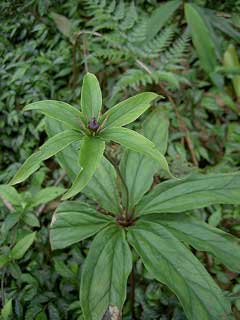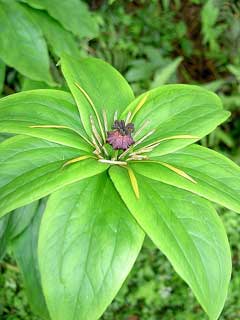 |
|
http://commons.wikimedia.org/wiki/User:Alnus |
 |
| http://commons.wikimedia.org/wiki/User:Alnus |
Translate this page:
Summary
Physical Characteristics

 Paris polyphylla is a PERENNIAL growing to 1 m (3ft 3in) by 0.3 m (1ft).
Paris polyphylla is a PERENNIAL growing to 1 m (3ft 3in) by 0.3 m (1ft).
See above for USDA hardiness. It is hardy to UK zone 8. It is in flower from July to August. The species is hermaphrodite (has both male and female organs). The plant is not self-fertile.
Suitable for: light (sandy) and medium (loamy) soils. Suitable pH: mildly acid, neutral and basic (mildly alkaline) soils. It can grow in full shade (deep woodland) or semi-shade (light woodland). It prefers moist soil.
UK Hardiness Map
US Hardiness Map
Synonyms
Paris polyphylla. Smith.
Plant Habitats
Woodland Garden Dappled Shade; Shady Edge; not Deep Shade;
Edible Uses
Edible Parts: Seed
Edible Uses:
Seed[105]. A sweet flavour, but mawkish[2].
References More on Edible Uses
Medicinal Uses
Plants For A Future can not take any responsibility for any adverse effects from the use of plants. Always seek advice from a professional before using a plant medicinally.
Analgesic Anthelmintic Antiphlogistic Antispasmodic Antitussive Depurative Febrifuge Narcotic
The roots are analgesic, antiphlogistic, antipyretic, antispasmodic, antitussive, depurative, febrifuge and narcotic[4, 147, 176, 218]. They posses anthelmintic properties[243]. A decoction of the roots is used in the treatment of poisonous snake bites, boils and ulcers, diphtheria and epidemic Japanese B encephalitis[147]. A paste of the roots is used as a poultice to treat cuts and wounds[272]. The juice of the roots has been used as an anthelmintic[272]. The roots have shown antibacterial action against Bacillus dysenteriae, B. typhi, B. paratyphi, E. coli, Staphylococcus aureus, haemolytic streptococci, Meningococci etc[176]. The whole plant is febrifuge[218].
References More on Medicinal Uses
The Bookshop: Edible Plant Books
Our Latest books on Perennial Plants For Food Forests and Permaculture Gardens in paperback or digital formats.

Edible Tropical Plants
Food Forest Plants for Hotter Conditions: 250+ Plants For Tropical Food Forests & Permaculture Gardens.
More

Edible Temperate Plants
Plants for Your Food Forest: 500 Plants for Temperate Food Forests & Permaculture Gardens.
More

More Books
PFAF have eight books available in paperback and digital formats. Browse the shop for more information.
Shop Now
Other Uses
References More on Other Uses
Cultivation details
Easily grown in a moist humus-rich soil in woodland conditions, succeeding in full or partial shade[90, 200, 233]. Prefers a light sandy loam[42]. This species is hardy to about -15°c according to one report[200], though another says that plants only succeed outdoors in southern and western Britain[42]. Overcollection of this plant from the wild for medicinal purposes is a cause of conservation concern[272]. A very variable species, with a large number of subspecies recognised[266]. Plants are very slow to flower from seed[137]. The individual flowers are very long-lived, lasting for up to 3 months[200, 233].
References Carbon Farming Information and Carbon Sequestration Information
Temperature Converter
Type a value in the Celsius field to convert the value to Fahrenheit:
Fahrenheit:
The PFAF Bookshop
Plants For A Future have a number of books available in paperback and digital form. Book titles include Edible Plants, Edible Perennials, Edible Trees,Edible Shrubs, Woodland Gardening, and Temperate Food Forest Plants. Our new book is Food Forest Plants For Hotter Conditions (Tropical and Sub-Tropical).
Shop Now
Plant Propagation
Seed - best sown as soon as it is ripe in late summer in light shade in a greenhouse. Sow stored seed in a greenhouse as soon as it is received. The seed is very slow to germinate. It produces a primary root about 7 months after sowing, this pulls the seed deeper into the soil. Leaves are produced about 4 months later[137]. Sow the seed thinly in fairly deep pots so that the seedlings can be grown on for their first two years without disturbance. Once they have germinated, give them a regular weak liquid feed to ensure that they do not suffer from nutrient deficiency. Once the plants are dormant at the end of their second year of growth, divide them up and put one plant in each pot. Grow them on for at least another year in a shady part of the greenhouse before planting them out into their permanent positions. Division.
Other Names
If available other names are mentioned here
Native Range
TEMPERATE ASIA: China (Anhui Sheng, Fujian Sheng, Gansu Sheng, Guangdong Sheng, Guangxi Zhuangzu Zizhiqu, Guizhou Sheng, Hubei Sheng, Hunan Sheng, Jiangsu Sheng, Jiangxi Sheng, Shaanxi Sheng, Shanxi Sheng, Sichuan Sheng, Xizang Zizhiqu, Yunnan Sheng, Zhejiang Sheng), Taiwan TROPICAL ASIA: Bhutan, India (Himachal Pradesh, Jammu and Kashmir, Sikkim, Uttar Pradesh (north)), Nepal, Myanmar (north), Thailand (north)
Weed Potential
Right plant wrong place. We are currently updating this section.
Please note that a plant may be invasive in one area but may not in your area so it's worth checking.
Conservation Status
IUCN Red List of Threatened Plants Status :

| Related Plants
|
| Latin Name | Common Name | Habit | Height | Hardiness | Growth | Soil | Shade | Moisture | Edible | Medicinal | Other |
| Arthrocnemum subterminale | Glasswort, Parish's glasswort | Perennial | 0.3 |
8-11
| | LMH | N | M | 3 | 0 | 2 |
| Berberis parisepala | | Shrub | 3.0 |
5-9
| | LMH | SN | DM | 2 | 2 | 1 |
| Capparis spinosa | Caper,Common Caper, Caper Bush | Shrub | 1.0 |
8-10
| F | LMH | N | DM | 2 | 3 | 3 |
| Capparis spinosa subsp. rupestris | Spineless Caper | Shrub | 1.2 |
6-10
| M | LM | N | DM | 3 | 2 | 3 |
| Chamaecyparis lawsoniana | Lawson Cypress, Port orford cedar, Oregon Cedar, Port Orford Cedar, Lawson's Cypress | Tree | 25.0 |
5-7
| M | LMH | SN | DM | 0 | 1 | 3 |
| Chamaecyparis nootkatensis | Nootka Cypress, Nootka Cypress, Yellow Cypress, Alaska Cedar | Tree | 15.0 |
4-8
| M | LMH | SN | DM | 0 | 1 | 3 |
| Chamaecyparis obtusa | Japanese cypress | Tree | 40.0 |
4-8
| M | LMH | N | M | 0 | 0 | 3 |
| Chamaecyparis pisifera | Sawara cypress | Tree | 40.0 |
4-8
| M | LMH | SN | M | 0 | 0 | 3 |
| Chamaecyparis thyoides | White Cypress, Atlantic white cedar, Coast White Cedar, Southern White Cedar, White Cypress | Tree | 10.0 |
4-9
| S | LMH | SN | DMWe | 0 | 1 | 3 |
| Cupressocyparis leylandii | Leyland Cypress | Tree | 40.0 |
6-10
| F | LMH | SN | M | 0 | 0 | 3 |
| Ericameria parishii | Heath Goldenrod, Parish's rabbitbrush | Shrub | 1.0 |
8-11
| | LMH | SN | M | 1 | 1 | |
| Liparis japonica | | Perennial | 0.3 |
-
| | LMH | S | M | 1 | 0 | |
| Paris quadrifolia | Herb Paris | Perennial | 0.3 |
5-9
| | LM | FS | M | 0 | 2 | 1 |
| Ribes divaricatum | Coastal Black Gooseberry, Spreading gooseberry, Parish's gooseberry, Straggly gooseberry | Shrub | 2.7 |
4-8
| | LMH | SN | M | 4 | 1 | 2 |
| Santolina chamaecyparissus | Cotton Lavender | Shrub | 0.6 |
6-9
| F | LM | N | DM | 2 | 2 | 3 |
|
Growth: S = slow M = medium F = fast. Soil: L = light (sandy) M = medium H = heavy (clay). pH: A = acid N = neutral B = basic (alkaline). Shade: F = full shade S = semi-shade N = no shade. Moisture: D = dry M = Moist We = wet Wa = water.
Now available:
Food Forest Plants for Mediterranean Conditions
350+ Perennial Plants For Mediterranean and Drier Food Forests and Permaculture Gardens.
[Paperback and eBook]
This is the third in Plants For A Future's series of plant guides for food forests tailored to
specific climate zones. Following volumes on temperate and tropical ecosystems, this book focuses
on species suited to Mediterranean conditions—regions with hot, dry summers and cool, wet winters,
often facing the added challenge of climate change.
Read More
Expert comment
Author
Sm.
Botanical References
51200266
Links / References
For a list of references used on this page please go here
Readers comment
© 2010, Plants For A Future. Plants For A Future is a charitable company limited by guarantee, registered in England and Wales. Charity No. 1057719, Company No. 3204567.